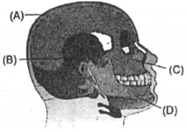HARD
Earn 100
The below diagram represents a human skull. Identify the parts labeled A, B, C and D from the given options:


(a)
| A | B | C | D | |
| (1) | Parietal | Temporal | Frontal | Mandible |
(b)
| A | B | C | D | |
| (2) | Temporal | Occipital | Frontal | Maxilla |
(c)
| A | B | `C | D | |
| (3) | Parietal | Temporal | Maxilla | Mandible |
(d)
| A | B | C | D | |
| (4) | Temporal | Parietal | Maxilla | Maxilla |
50% studentsanswered this correctly
Important Questions on Locomotion and Movement
MEDIUM
EASY
HARD
EASY
EASY
HARD
MEDIUM
Match the following.
| SET-I | SET-II | ||
| (A) | Os penis | (I) | Sesamoid bone |
| (B) | Girdle | (II) | Visceral bone |
| (C) | Patella | (III) | Cartilage bone |
| (D) | Cranium | (IV) | Investing bone |
EASY
EASY
EASY
MEDIUM
EASY
HARD
MEDIUM
EASY
EASY
EASY
MEDIUM
Match the following columns and select the correct option.
| Column-I | Column-II | ||
| (a) | Floating Ribs | (i) | Located between second and seventh ribs |
| (b) | Acromion | (ii) | Head of the Humerus |
| (c) | Scapula | (iii) | Clavicle |
| (d) | Glenoid cavity | (iv) | Do not connect with the sternum |
EASY
EASY

